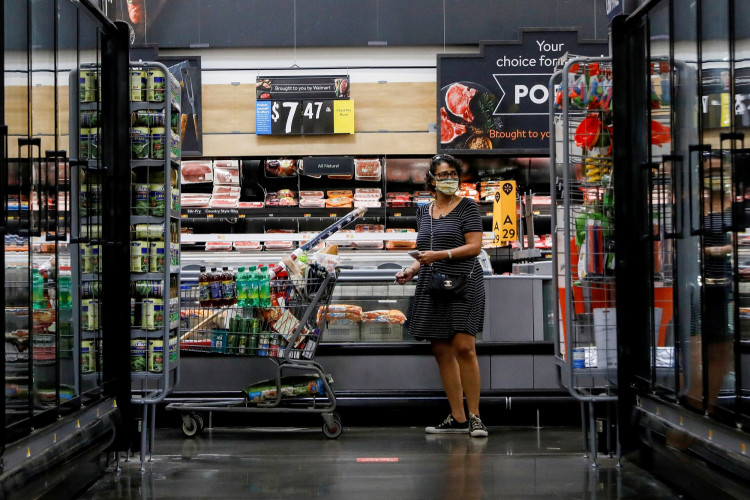On September 29, the U.S. Department of Commerce reported that the August core Personal Consumption Expenditures (PCE) price index's year-over-year growth rate dropped from 4.3% in July to 3.9%. This marks the lowest level for the index in two years, indicating a slowdown in U.S. underlying inflation.
The core PCE price index, which excludes food and energy, measures the price changes of goods and services purchased by consumers and is a key gauge of U.S. inflation. The Federal Reserve has long monitored the PCE price index to adjust monetary policy in response to inflation.
Eric Freedman, Chief Investment Officer at Union Bank Asset Management, noted that while the inflation data is better than anticipated, it's still trending upward.
Month-over-month, the overall PCE price index grew by 0.4%, up from the previous 0.2%. Goods prices increased by 0.8%, and service prices by 0.2%. Food prices rose by 0.2%, while energy prices surged by 6.1%. Excluding food and energy, the core PCE price index saw a slight increase of 0.1%, down from the previous 0.2%.
Year-over-year, the overall PCE price index for August rose by 3.5%, up from the previous 3.4%. Excluding food and energy, the core PCE index increased by 3.9%, down from the previous 4.3%.
The report also highlighted that in August, per capita income in the U.S. increased by $87.6 billion, a 0.4% month-over-month rise. Disposable Personal Income (DPI) grew by 0.2%, adding $46.6 billion, and Personal Consumption Expenditures (PCE) increased by $83.6 billion, a 0.4% rise.
Following the report's release, U.S. stocks briefly rose before retreating, marking a challenging month and quarter for the stock market. By the close on September 29, the Dow Jones fell by 158.84 points or 0.47% to 33,507.50. The S&P 500 declined by 11.65 points or 0.27% to 4,288.05, while the Nasdaq Composite rose by 18.05 points or 0.14% to 13,219.32.
For September, the S&P 500 dropped 4.9%, the Dow 3.5%, and the Nasdaq 5.8%. In the second quarter, the S&P 500 fell about 3.6%, the Dow 2.6%, and the Nasdaq 4.1%, marking the first quarterly decline for the three major indices in 2023.
The dip in the core PCE price index led some investors to believe that the Federal Reserve might pause rate hikes, causing a brief uptick in U.S. stocks. However, as Quincy Krosby, Chief Global Strategist at LPL Financial, pointed out, while the Fed might be pleased with the overall direction shown by the PCE report, it's too early to declare victory in curbing inflation.
The Fed's target inflation rate for healthy economic growth is 2%, a level last reached in February 2021.
According to Reuters, this report might be the last official economic data released before a potential U.S. government shutdown. Concerns about a shutdown are pressuring the market. If the government does shut down, investors will have more factors to consider.
Previously, due to the House Republicans' demands for spending cuts being rejected by Senate Democrats, both chambers couldn't agree on the 2024 fiscal year budget. If Congress doesn't pass a spending bill by midnight local time on September 30, the federal government will shut down.
On September 29, the House rejected a "Continuing Resolution" agreement to extend the new fiscal year's spending bill by 30 days to avoid a government shutdown, with a vote of 232 against 198. It's almost certain that parts of the federal government will shut down starting Sunday. If funding isn't secured, the shutdown will result in the closure of national parks and 4 million federal employees going without pay.
It's unclear whether the Senate will take action. The Senate was scheduled to review a bipartisan bill on September 30 that would fund the government until November 17. However, procedural hurdles might delay the final vote until October 3.
U.S. Treasury Secretary Janet Yellen stated on September 29 that a government shutdown would lead to small businesses closing, thereby "derailing" U.S. economic progress and potentially delaying major infrastructure improvements.
Additionally, if the government shuts down and services are interrupted, millions could lose access to food and assistance, impacting personal spending. According to Reuters, the U.S. savings rate has slid from 4.1% last year to 3.9%, the lowest since last December. If savings continue to decrease, combined with rising gas prices and other factors, personal spending could be suppressed.
Chris Fasciano, Portfolio Manager at Commonwealth Financial Network, said the market needs to consider how to handle a potential government shutdown, including its duration and how it might impact short-term economic data, consumer confidence, and interest rates.






